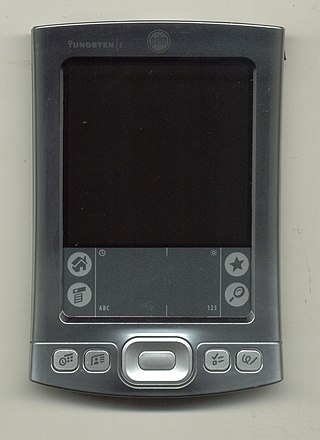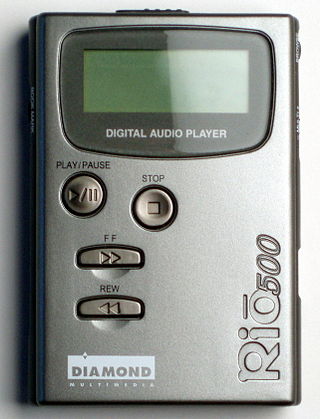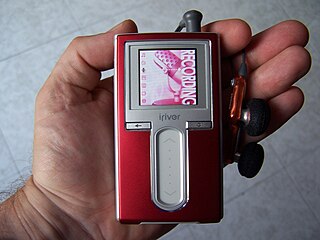Casio Cassiopeia was the brand name of a PDA manufactured by Casio. It used Windows CE as the Operating system. Casio was one of the first manufacturers of PDAs, developing at the beginning small pocket-sized computers with keyboards and grayscale displays and subsequently moving to smaller units in response to customer demand.

The Tapwave Zodiac is a mobile entertainment console and personal digital assistant. Tapwave announced the system in May 2003 and began shipping in October of that same year. The Zodiac was designed to be a high-performance mobile entertainment system centered on video games, music, photos, and video for 18- to 34-year-old gamers and technology enthusiasts. By running an enhanced version of the Palm Operating System (5.2T), Zodiac also provided access to Palm's personal information management software and many other applications from the Palm developer community. The company was based in Mountain View, California.
The Motorola MPx200 smartphone was launched in December 2003 as a joint venture between Motorola and Microsoft. The mobile phone's Windows Mobile for Smartphone OS allows users to access email and the Internet, use MSN Messenger, and view documents in Microsoft Office formats much like other Windows smartphones such as the Samsung SGH-i600 or HTC Tanager. The MPx200, along with the Samsung SCH-i600, were the first Windows Mobile smartphone devices to have wide distribution in the United States. Previously, smartphone platform devices could only be purchased in the United States as part of development kits sold by Microsoft. The only U.S. carrier of the phone was AT&T Wireless; however, reports also suggest a somewhat limited number of devices with Cingular branding have appeared following the purchase of AT&T Wireless by Cingular.

The Tungsten series was Palm, Inc.'s line of business-class Palm OS-based PDAs.

The AAA battery is a standard size of dry cell battery. One or more AAA batteries are commonly used in low-drain portable electronic devices. A zinc–carbon battery in this size is designated by IEC as R03, by ANSI C18.1 as 24, by old JIS standard as UM-4, and by other manufacturer and national standard designations that vary depending on the cell chemistry. The size was first introduced by The American Ever Ready Company in 1911. They're called #7 batteries in China, the name originating from the Burgess Battery Company designating his AAA batteries "Number 7".

The Rio PMP300 is one of the first portable consumer MP3 digital audio players, and the first commercially successful one. Produced by Diamond Multimedia, it was introduced September 15, 1998 as the first in the "Rio" series of digital audio players, and it shipped later that year.

The Personal Jukebox was the first consumer hard drive-based digital audio player. Introduced in 1999, it preceded the Apple iPod, SanDisk Sansa, and other similar players. It was designed and developed by Compaq Research starting in May 1998. Compaq did not release the player themselves, but licensed the design to HanGo Electronics Co., Ltd. of South Korea.

A portable media player (PMP) or digital audio player (DAP) is a portable consumer electronics device capable of storing and playing digital media such as audio, images, and video files. The data is typically stored on a compact disc (CD), Digital Versatile Disc (DVD), Blu-ray Disc (BD), flash memory, microdrive, SD cards or hard drive; most earlier PMPs used physical media, but modern players mostly use flash memory. In contrast, analogue portable audio players play music from non-digital media that use analogue media, such as cassette tapes or vinyl records.

The Microdrive is a type of miniature, 1-inch hard disk produced by IBM and Hitachi. These rotational media storage devices were designed to fit in CompactFlash (CF) Type II slots.

Mini CDs, or pocket CDs, are CDs with a smaller diameter and one-third the storage capacity of a standard 120 mm disc.
Olympus m:robe was a product line of MP3 players that were produced by Olympus Corporation between 2004-2005. The name m:robe is a contraction of Music wardROBE. Olympus has ended production of the entire m:robe line. On October 13, 2004, Olympus released two MP3 players: the 5GB MR-100 with monochrome display and the 20GB MR-500i with colour display and built-in camera. The MR-100’s release price was $249.99 (USD), and the MR-500i’s release price was $499.99 (USD). The later MR-F10, MR-F20, and MR-F30 players with color screens, drag-and-drop file transferring, and FM tuning and recording were only released in Asia.

The loosely defined category of S1 MP3 players is comprised by a large amount of then-inexpensive handheld digital audio players. The players were mainly widespread around 2005–2006 but the series continued for years afterwards, blurring into that of so-called "MP4 players" employing S1 and competing architectures.

Yepp was Samsung Electronics' digital audio player brand until Samsung decided to retire most of their family brands in February 2011. From then on, their MP3 players were simply branded "Samsung" worldwide until they discontinued all of them in late 2013. The brand included a wide range of hard-drive based as well as flash-memory based players. The name is claimed to be an acronym for "young, energetic, passionate person".

The Rio 500 is considered the first of the Second Generation MP3 digital audio player, and was produced by Diamond Multimedia. It shipped September 22, 1999. The Rio 500 was the successor of the Rio PMP300, and provided a number of user requested features. There were many reviews of the Rio 500.

SanDisk has produced a number of flash memory-based digital audio and portable media players since 2005. The current range of products bears the SanDisk Clip name. SanDisk players were formerly marketed under the Sansa name until 2014.

Nokia 5300 XpressMusic is a slider mobile phone by Nokia, part of the XpressMusic range. It was introduced on 26 September 2006 and released at the end of that year. It runs on Nokia Series 40 3rd Edition FP2.

The PlayStation Portable's hardware consists of the physical components of the PlayStation Portable (PSP) and its accessories.
The Zii EGG is a handheld product platform from Creative Technology subsidiary ZiiLABS. According to ZiiLABS, the Zii Egg was designed for OEM sales, meaning that the device was marketed to sell to third parties rather than retail customers where they can modify it and sell it under their own brand rather than Creative or ZiiLABS. Creative later introduced a consumer model, the Creative Zii. The Egg was announced at the end of July 2009 with ZiiLABS' Plaszma OS platform and support for Google's Android OS. The EGG was shipped from ZiiLABS in the later half of August 2009. The first available firmware with Android was released on November 2, 2009.

The H10 is a series of portable audio players developed by iRiver, coming in multiple capacities and sizes. The player first went on sale in South Korea in December 2004 and rolled out internationally soon afterwards. The H10 series are hard disk based players coming in a 20 gigabyte form, along with smaller variants of 5 or 6 gigabytes. All versions come with a colour screen as well as voice recording and FM radio. Unlike most other iRiver products, the H10 series does not play Ogg Vorbis. However, the device works well with the Rockbox alternative firmware which does play Ogg Vorbis.
The Sony Clie UX series were premium multimedia PDAs announced by Sony in July 2003, running Palm OS. These devices were advertised as being a "personal entertainment communicator", a purpose not dissimilar to the Apple iPod Touch released in 2007. Two models were released, featuring a "palm-top" clamshell design, with a landscape tilting and swiveling LCD screen.















